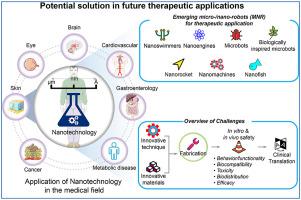Biomaterials ( IF 14.0 ) Pub Date : 2020-05-30 , DOI: 10.1016/j.biomaterials.2020.120163 Vibhuti Agrahari , Vivek Agrahari , Ming-Li Chou , Chew Ho Chew , James Noll , Thierry Burnouf

|
Nanotechnology and microfabrication approaches are playing instrumental roles in the development of innovative technologies to fight human diseases. Because of promising in vitro and preclinical outcomes, micro-/nanorobots (MNRs), are increasingly being considered for personalized and precision therapeutic diagnoses, sensing, drug delivery, and surgery. Today, designing MNR-based devices to improve the safety and efficacy of drugs for select cells/tissues represents a novel and promising area of therapeutic development. Progress has primarily been due to many scientific breakthroughs made in design, fabrication, and operational technologies, which have greatly enhanced the capabilities of MNRs to meet the requirements of biomedical applications. This review focuses on the development and emerging biomedical applications of micro-/nanostructures encompassing nanoswimmers, nanoengines, 3D-motion nanomachines, and biologically inspired microbots, nanofish, and nanorockets. Promising applications of these devices in various therapeutic areas are discussed. We examine the impacts of the rapid progress made in developing these novel devices for drug delivery applications. We also summarize the current fabrication, scale-up development, and clinical translational challenges faced and the main roadblocks that need to be overcome, particularly those related to patient safety and personalized medicine approaches, areas that require the design of safe innovative materials. As MNR systems are new, scientists should systematically investigate their behavior/functionality, biocompatibility, toxicity, biodistribution, and efficacy head-on before considering any potential clinical evaluations. Although still an emerging area, MNRs are steadily becoming a realistic prospect as vital future therapeutic tools for a vast array of applications.
中文翻译:

智能微/纳诺机器人作为生物医学治疗领域的药物和细胞载体设备:广阔的发展机遇和翻译挑战。
纳米技术和微细加工方法在开发创新技术以抗击人类疾病方面发挥着重要作用。因为有希望的体外微型/纳米机器人(MNR)和临床前成果,正日益被用于个性化和精确的治疗诊断,传感,给药和手术。如今,设计基于MNR的设备以提高用于选择的细胞/组织的药物的安全性和功效代表了一种新的,有希望的治疗领域。进步主要归功于设计,制造和操作技术方面的许多科学突破,这些突破大大增强了MNR满足生物医学应用要求的能力。这篇综述的重点是微/纳米结构的发展和新兴的生物医学应用,包括纳米游泳器,纳米引擎,3D运动纳米机器以及受生物启发的微型机器人,纳米鱼和纳米火箭。讨论了这些设备在各种治疗领域中的应用前景。我们研究了开发用于药物输送应用的新型设备所取得的迅速进展的影响。我们还总结了当前的制造,规模开发和临床转化面临的挑战,以及需要克服的主要障碍,特别是与患者安全和个性化医疗方法有关的障碍,这些领域需要设计安全的创新材料。由于MNR系统是新的,因此在考虑任何潜在的临床评估之前,科学家应系统地研究其行为/功能,生物相容性,毒性,生物分布和功效。虽然仍然是新兴领域,


























 京公网安备 11010802027423号
京公网安备 11010802027423号